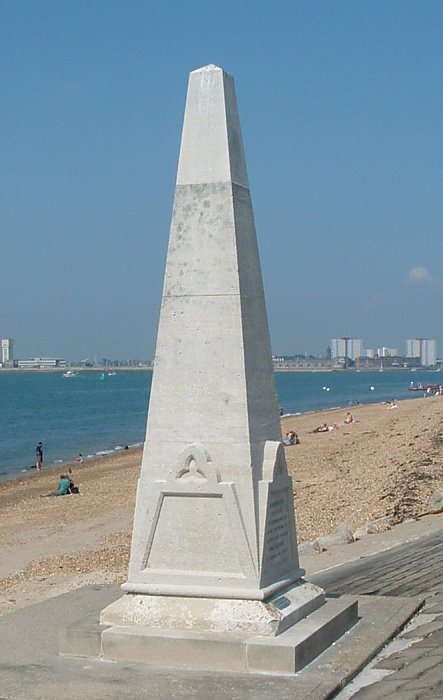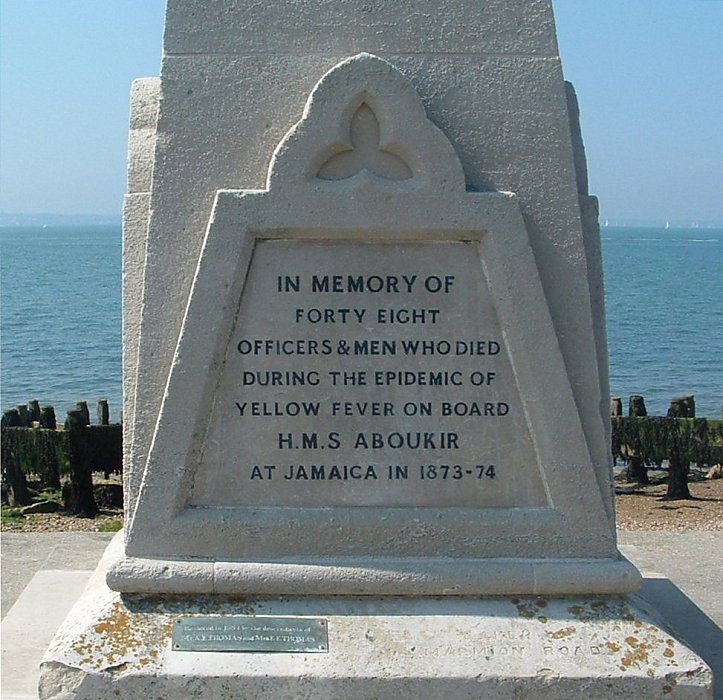Location
Opposite the Royal Naval Memorial on Clarence Esplanade.
Description
This monument is a stone column, consisting of four tapering pieces amounting to 12 ft in height, set on a square base and plinth 4 ft sq. The memorial has been restored on several occasions.
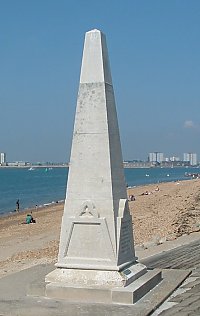
Memorial (Plaque 1)
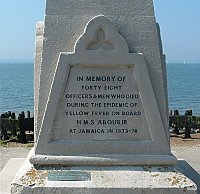
Memorial (Plaque 3)
 Click images above to enlarge
Click images above to enlargeMemorial (In 2002)
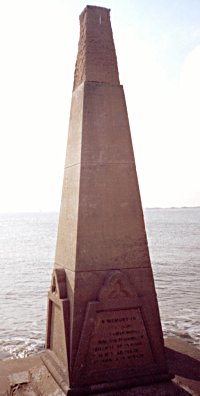
Memorial (In 1971/©PCC)

HMS Aboukir
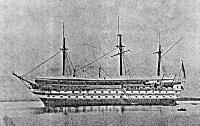
FORTY EIGHT
OFFICERS & MEN WHO DIED
DURING THE EPIDEMIC OF
YELLOW FEVER ON BOARD
H.M.S. ABOUKIR
AT JAMACA IN 1873-74
Inscription 2
COMMODORE
A.F.R.De HORSEY A.D.C.
THE OFFICERS AND MEN
1873-74 ON BOARD
H.M.S. ABOUKIR
Inscription 3
Mr A.E.THOMAS and E.E.THOMAS.
Further Information
HMS Aboukir was the third ship of that name. It was named after The Battle of the Nile (1798) which was fought in Aboukir Bay. She was a ship of 3,080 tons, 204 X 60 feet and draught 19 feet. She carried 90 guns and a crew of 830 men and was launched at Devonport Dockyard on 4th April 1848
She later became a screw ship with engines of 400 h.p. and 3,091 tons and from 1863 - 1877 she acted as receiving ship at Jamaica, where she was sold on 23rd November 1877.
Extract From Hansard (18th June 1874)
MR. HUNT, [First Lord of the Admiralty], said, reports of the outbreak of yellow fever on board the Aboukir were received at the Admiralty at the end of December last. Previous to the receipt of this intelligence a body of supernumeraries, numbering 140, had been sent to Jamaica en route to the Pacific Station. At the time of the outbreak, which was caused by a marine returning from leave—yellow fever being prevalent in the town of Kingston—there were about 283 officers and men on board. Besides cases of ordinary fever, 33 cases of yellow fever occurred, of which 21 in all were fatal, some of these being seamen living on shore as the Commodore's boat's crew. On receipt of the news of the outbreak of fever, orders were sent on the 1st of January last by telegraph to the Commodore at Jamaica to move the officers and men into barracks or tents on shore, and, if necessary, to charter a ship to take the sick to Halifax or Bermuda. Previous, however, to the receipt of these orders, the Commodore had considered it expedient to embark the officers and men of the Aboukir on board Her Majesty's Ships Sphinx, Niobe, and Seagull, and to send them to the northern division of the station. The Commodore also adopted vigorous measures for cleansing, fumigating, and ventilating the ship, and on the return on the 27th of April of the Sphinx with the regular crew of the Aboukir, the supernumeraries having gone on to their destination, he was of opinion that they might without danger be re-embarked in their own ship, in which opinion the Deputy Inspector of Hospitals concurred. No order, however, for their re-embarkation had been sent from England. At the end of May the Commodore reported that, although objections had been offered by the new Deputy Inspector General of Hospitals and the Staff Surgeon of the ship to the re-embarkation of the crew, which had been carried out with the concurrence of the previous Deputy Inspector, he was of opinion that there was no danger of a 74 fresh outbreak; but that the vessel was not permanently fit for a receiving ship, and that fresh cases of fever might occur at the unhealthy season of the year. After due consideration of this Report, it was decided to prepare Her Majesty's Ship Urgent with the utmost despatch to take the place of the Aboukir, and instructions were sent by the last mail to the Commodore, in case of any fresh outbreak, to remove the crew to quarters on shore, and to employ native seamen, who were not so susceptible of infection, as far as possible on the duties of the ship. The ship was surveyed in March, 1873, was reported unfit to go to sea, and the surveying officers recommended that as soon as relieved she should be sold. In a subsequent Report of the 10th of May, 1873, she was reported to be healthy and sweet.
The Restoration of the Memorial
Portsmouth City Council Minutes (1984: Min 338)
"An offer has been received from former residents of Portsmouth to contribute towards the restoration of one of the ancient monuments along the seafront as a tribute to the late
Mr. A.E. Thomas and Mrs. E.E. Thomas.
Following discussions the Aboukir Monument, which is in serious need of restoration has been chosen.
The amount of the contribution will be £2,000 and would meet the cost of the following works:-
1. Removal of existing deteriorating lettered panels and replacement new panels.
2. Removal of top 750 mm of the Portland stone obelisk (severely eroded) and replacement with new stone.
The works referred to above are those most urgently required to the Aboukir Monument, other works estimated to cost approximately £4,100 are also required, and it is the intention of the City Museums Officer to undertake these works in future years if resources permit."
[Research by Cynthia Sherwood]
The photograph (fifth, left) taken in 1971 shows the extent of erosion to the whole memorial. Another taken in 1990 after the restoration work had been completed (in 1986) shows that almost the entire memorial had been replaced but that the top section was already beginning to deteriorate again. The picture taken in 2002 confirmed that the process of deterioration was continuing. The latest attempt to stabilise the memorial took place in 2012.

